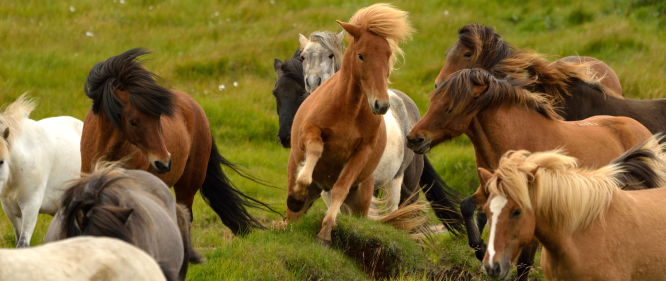The Icelandic Horse: A Small Giant With A Big Personality

Did you know that Iceland has its very own breed of horse? Though small in stature, the Icelandic horse is anything but ordinary. This ancient breed arrived in Iceland with the Vikings in the 9th century and has been an essential companion to Icelanders ever since. Some might call it a pony due to its size, but make no mistake—this horse is a hardy survivor, perfectly adapted to Iceland's rugged terrain and extreme weather.

Built for Iceland's Tough Terrain, Adopted Around the World!
Despite their size, Icelandic horses are strong and resilient. They’ve been crossing lava fields, icy rivers, and rough landscapes for over a thousand years, growing thick winter coats to endure the cold. The breed remains virtually unchanged since it first arrived on the island, and like the stylish locals, their coats come in a variety of beautiful colors, including shades like Cremello, Blue Dun, and Chestnut with a flaxen mane. These horses are not only tough but also versatile, and today, they can be found in places as diverse as Alaska, Australia, and even Hawaii! As of 2024, there are over 300,000 registered Icelandic horses around the world, with 40% of them still living in Iceland. Their friendly, curious, and cooperative nature makes them easy to ride and a joy for horse enthusiasts everywhere. Icelandic horses are known for their intelligence and quick learning, making them ideal companions for both beginners and experienced riders. Whether in Iceland or abroad, these horses symbolize the strong cultural bond between Iceland and the rest of the world.

Unique Gaits: The Tölt and Flying Pace
One of the most fascinating things about the Icelandic horse is its special gaits. The signature gait for the breed is the Tölt, a smooth, four-beat gait that allows the rider to stay perfectly balanced. This gait was rumored to be so even and smooth that you could ride with a full horn of mead and be able to drink while riding.Its main purpose was for long distance travel which was quite common in our 1200 year history as carriages and later cars could not travel over the rough terrain due to lack of roads.! Then there’s the Flying Pace, or Skeið, which is fast and exhilarating, reaching speeds of up to 50 km/h (30 mph). This gait is used in short bursts, often during racing, and gives riders an unforgettable adrenaline rush!

Exploring Iceland on Horseback, Horse Care and Training
If you’re visiting Iceland, one of the best ways to experience the country’s unspoiled nature is on horseback. Riding tours are offered across the island, often just a short drive from Reykjavík, and cater to all experience levels. Whether you want a half-day tour or a multi-day adventure through Iceland’s striking landscapes, there's something for everyone. However, winter tours can be limited due to weather conditions, so it’s always good to check availability in advance. Icelandic horses are typically raised in herds and live outdoors most of the year. Only riding horses are stabled during winter, while the rest roam freely across pastures during summer and autumn. Summer is the time for longer riding trips, where groups of riders venture into the Icelandic Highlands with spare horses running free behind them. These trips, often lasting days or weeks, are planned with great care during the winter months. After the busy summer season, horses enjoy an "autumn break," roaming freely in herds to regain their strength before winter training begins.

A Mythical Companion in Iceland’s Sagas
The Icelandic horse holds a special place in local folklore, often believed to have connections with elves and hidden folk. Legends speak of these horses serving as protectors, with magical powers such as healing. The bond between humans and horses in Iceland runs deep, with stories of horses saving lives or even being buried alongside their owners to accompany them to Valhalla. They are also thought to possess psychic abilities, sensing ghosts and spirits in the dark. The influence of the horse extends into Iceland’s natural landscape as well. Some mountains and landmarks are named after horses, like the mountain Hestur, said to have been a troll’s horse turned to stone under the weight of too much baggage. Ásbyrgi Canyon in the north is even believed to have been formed by the hoofprint of Sleipnir, the eight-legged horse of the god Ódin. The Icelandic horse has inspired countless poems and songs, cementing its role as a local cultural icon. Throughout Icelandic history and folklore, the horse has often been portrayed as both a loyal companion and a hero. Many sagas tell of horses saving their owners’ lives, and during the Viking era, some horses were buried with their warriors, believed to join them in the afterlife. Horses were not just work animals but had a deep connection to their owners and played vital roles in Iceland’s history.

A Horse for Every Task
In Iceland’s past, horses were essential for everything: transporting goods, carrying people to church or doctors, and even delivering mail across glacial rivers. They also provided meat, horsehair, and milk. Their role has changed dramatically in modern times, but they remain an important cultural symbol, both within Iceland and across borders.

Protecting the Icelandic Horse
Iceland’s isolation has protected its horses from many equine diseases, which means no vaccinations are needed here. However, this also means no horses or other equines can be imported. Once an Icelandic horse leaves the country, it can never return. Visitors are kindly (but seriously) asked not to bring used riding equipment such as gloves, chaps, or boots. All other gear should be properly disinfected to protect Iceland’s herd.

Whether you’re an experienced rider or just curious about Iceland’s culture, the Icelandic horse is an enduring symbol of resilience, adventure, and tradition. From its unique gaits to its place in folklore, this small but mighty horse continues to capture the hearts of people all over the world.


